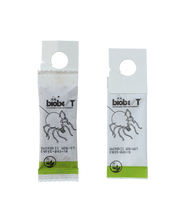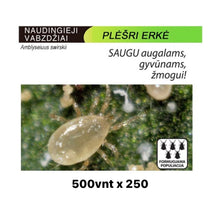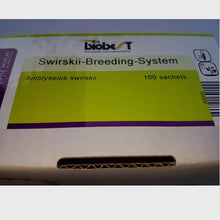For the control of whiteflies and thrips in garden, vegetable garden, greenhouse and indoor plants. Delivered in bags: 1 pc. 250 units each ticks in each 500 pcs. bags. It is recommended to choose at the initial stage of pest infestation.
Instructions for use
BIOFRIENDS beneficial insects - PREDATORY TICKS (Amblyseius swirskii), 25000 pcs.
The predatory mite eats whitefly eggs, larvae and thrips larvae. One tick eats about 5-10 pests per day. It adapts particularly well to high temperatures. Predatory mites can survive longer without food (bad insects) by feeding on only pollen, unlike other beneficial insects. They can be used as prevention even in the early, barely noticeable stage of pest infestation. Since adult mites do not have the ability to fly away and the development cycle is very intensive, the possibility of continuous control of plant pests remains. The number of pests decreases within 3 weeks.
PURPOSE
- For the maintenance and pest control of various vegetables, fruits, ornamental plants
- They are used in open fields, greenhouses, houses, public premises
- They are used throughout the year to treat both single and entire areas infested with pests
ADVANTAGES
- Remains active at 15°C and 40°C
- Resistant to fluctuations in humidity
- It also acts as a preventive measure for pest control
- A tick population is forming
USAGE
Predatory ticks are delivered in bags: 100 pcs. 250 units each ticks in each.
Ticks are transported together with bran, which represents a food source, to prevent cannibalism by ticks. Therefore, immediately after receiving them, hang the bags in the centers of pests. Hang the mite bag above or on plants where pest control is needed:
- for preventive pest control - 1 bag / 2 m²
- for high prevalence of pests - 1 bag / 1 m²
- it is recommended to use it every 4-6 weeks (when used, the mite population is constantly formed, which ensures good biological control)
If the plants are large or they are not in contact with each other, we recommend hanging 1 bag per plant.
Ticks crawl out of the bags gradually - some crawl out, some reproduce in the package. In the course of 6 weeks, while the ticks are moving from the package to the infested plants, the number of ticks increases from 250 pcs. up to 2000 units It is recommended to choose at the initial stage of pest infestation.






